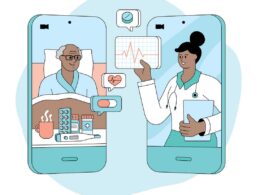Journal of Primary Health Care
Andrew Ure
Gore Medical Centre, New Zealand.
3 March 2022
Key messages
Summarized by Joaquim Cardoso MSc
Health Revolution Institute
Virtual Care Revolution Unit
April 30, 2022
Summary about the paper
- Telephone triage involves diverting requests for same-day healthcare to a phone system where presenting complaints are explored only sufficiently to identify the most appropriate management pathway.
- Gore Medical Center (NZ) conducted a study to assess the rates of repeat triage among general practice patients treated virtually via phone and compare these with outcomes for patients who were dealt with in person.
- The showed that virtual treatment via telephone triage resulted in 14% re-triage of cases over the 6-week period.
- There was a statistically significant difference between virtual and in-person care in terms of the need for re-triage within 7 days with in-person treatment after triage reducing the re-triage rate to 7%.
- This raises questions about the efficacy of virtual treatment via telemedicine compared with in person treatment after triage.
Notes from the editor of the blog:
- It is mentioned that virtual treatment via telephone triage resulted in 14% re-triage of cases over the 6-week period. We didn´t find a reference for re-triage rate of in person triage, to be able to compare the results among the two models.
- Figure 4 shows that the rates of virtual treatment rates per clinician varied between providers ( from around 15% to 45%). We did not find an explanation for such variation.
- We didn´t find recommendations of possible strategies to improve the results, such as: (a) Improvements in the cure process; (b) Improvement in the Education and Training of Triage Professionals; (c) Triage conducted by Physicians; (d) Help of digital tools, etc
ABSTRACT
Introduction:
Telemedicine, including telephone triage, is increasingly being used in New Zealand general practices.
Telephone triage involves diverting requests for same-day healthcare to a phone system where presenting complaints are explored only sufficiently to identify the most appropriate management pathway.
Aim:
To assess the rates of repeat triage among general practice patients treated virtually via phone and compare these with outcomes for patients who were dealt with in person.
Method:
6 weeks of clinical telephone triage data were collected for Gore Medical Centre.
Comparisons were made for patients treated virtually or in person, for whether complaints were a respiratory issue or not, and for whether their triage represented incomplete resolution of a previously triaged health complaint.
To do this, patient notes for the 7 days prior to the phone triage were reviewed for medical consultations related to the same condition.
Results:
Over 6 weeks, 455 telephone triages took place at the Gore Medical Centre: 133 triage phone calls resulted in 132 (29%) patients being treated virtually.
Over the 6 study weeks, 19 virtually treated triage patients phoned again for further care of the same problem within 7 days (14%) while 23 patients (7%) who had been triaged to in person assessment also sought further care within 7 days.
This difference was statistically significant ( P < 0.05). There was no statistical difference in re-triage rates between Māori and non-Māori. Young age was a significant predictor for likelihood of re-triage.
Discussion:
Virtual treatment via telephone triage at Gore Medical Centre resulted in a statistically increased likelihood of re-triage within 7 days compared with in person treatment.
This raises questions about the efficacy of virtual treatment via telemedicine compared with in person treatment after triage.
Virtual treatment via telephone triage at Gore Medical Centre resulted in a statistically increased likelihood of re-triage within 7 days compared with in person treatment.
This raises questions about the efficacy of virtual treatment via telemedicine compared with in person treatment after triage.
WHAT GAP THIS FILLS
What is known about this topic:
Telemedicine, including telephone triage for acute health issues is increasingly being used in primary care. Telemedicine is generally recognised as a safe and effective method to provide health care within the community.
What this research adds:
Virtual telemedicine outcomes and in-person outcomes are not necessarily equivalent. Virtual management of acute presentations can result in higher demand for repeat clinical assessments than in-person treatment.

Introduction
Over the past few years telephone triage has become an important tool for care provision in New Zealand general practice.
Telephone triage involves diverting requests for same-day healthcare to a telephone system where presenting complaints are explored only sufficiently to identify the most appropriate management pathway.
It has been crucial for providing medical care during the Covid-19 pandemic.
Various clinical concerns have been raised regarding the safety and efficacy of telephone triage both locally and internationally.1–3
Given the pressures on general practice in New Zealand, a key question has been whether higher rates of virtual care are associated with higher rates of re-presentation for issues that were incompletely dealt with by phone, representing a false economy of care.
To address this question in a New Zealand context, 6 weeks of telephone-triage data were examined and audited to examine rates of repeat presentation after telephone triage at Gore Medical Centre.
Gore Medical Centre has approximately 8250 enrolled patients and, at the time of the audit, approximately 5.6 full-time-equivalent General Practitioners (GPs).
The 6 weeks that this audit covered coincided with a local rise in respiratory cases at the start of winter 2021 due to a national Respiratory Syncytial Virus (RSV) outbreak.
This increase in respiratory cases combined with the need to offer Covid testing to patients with respiratory symptoms significantly reduced the number of patients being treated remotely.
Before the Covid pandemic the majority of senior GPs managed 45–60% of triage patients by virtual care. That level is higher than rates documented in this audit.
Before the Covid pandemic the majority of senior GPs managed 45–60% of triage patients by virtual care. That level is higher than rates documented in this audit.
The process for telephone triage used at Gore Medical Centre is shown in Fig. 1.
Fig. 1. Triage process — GMC.

To improve efficiency for the triage system in the current Covid-19 pandemic, and due to the high likelihood of an in person review for people with respiratory symptoms, Gore Medical Centre has two 30-min time slots each day for nurses to assist GPs with triage of respiratory patients from the phone list.
This meant patients with respiratory symptoms were dealt with by a different set of clinicians from patients without respiratory symptoms.
… Gore Medical Centre has two 30-min time slots each day for nurses to assist GPs with triage of respiratory patients from the phone list.
This meant patients with respiratory symptoms were dealt with by a different set of clinicians from patients without respiratory symptoms.
Method
Six weeks of telephone-triage data were collected for Gore Medical Centre from Monday 24 May to Friday 2 July 2021. Data were stratified depending on whether patients were treated remotely or not, whether patients had respiratory symptoms or not, and whether their triage represented incomplete resolution of a condition that had been dealt with through phone triage within the previous 7 days (representing a re-triage call).
To do this, notes for all patients triaged over the 6 weeks were reviewed. Medical records for the 7 days before the phone triage were searched for prior medical consultations regarding the same condition — whether respiratory or another condition. For patients triaged in the first week of the study this involved reviewing notes that preceded the 6-week window of the study. Where a patient re-presented with the same condition within 7 days, note was taken of whether the previous consultation was virtual or in person.
Triage data were recorded in an anonymised form on an excel spread sheet. Demographic data for the 6 weeks was documented from patient notes and from the WellSouth Primary Health Organisation’s Key-Performance Indicator (KPI) data automatically recorded for triage using a KPI form which is embedded in the Medtech Evolution electronic Patient Management System (PMS).
These demographic data were slightly different from the actual triage data as 28 triage calls initially recorded a ‘no-contact’ phone result before the patients were later contacted.
Ethnicity data used the enrolment coding for patients. Statistical significance was tested using an online calculator at www.openepi.com to perform Chi-squared tests and calculate Odds Ratios (ORs) and Confidence Intervals (CIs).
Results
Over 6 weeks 455 phone triages took place at Gore Medical Centre, representing an average of 15.6 phone triages per day.
More than half (251; 55%) of triage calls involved female patients while 204 (45%) involved males. The number of calls varied from 36 on the busiest day to 5 calls on the lightest day.
The distribution of call numbers is shown in Table 1. The average number of calls each day is shown in Fig. 2, while the age distribution of patients seeking same-day care via telephone triage are shown in Fig. 3.
Table 1. Triage statistics by date.

Fig. 2. Age distribution of triage cases.

Fig. 3. Average daily triage numbers.
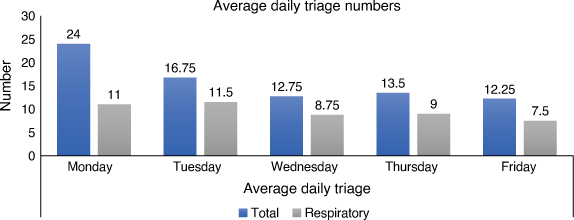
Of the 455 calls, 300 were respiratory related (66% of calls). Consistent with health guidelines during the Covid-19 pandemic, most of these patients were offered an in-person review, with only 65 (22%) treated virtually.
The balance of calls (155) were about non-respiratory conditions. Of these, 68 (44%) were treated virtually. Over the 6 weeks, 321 patients were triaged to in-person consultations. Only one person out of the 455 calls could not be contacted for triaging.
Ethnicity
The impact of ethnicity on utilisation and outcomes of clinical triage was examined to assess equity of access and outcome.
The WellSouth-KPI data showed that 9.5% of calls involved Māori patients. This indicates a slightly higher utilisation rate than the enrolled percentage of 8.8% Māori (722/8250). There was no significant difference (P = 0.34, OR = 1.38, CI = 0.70, 2.65) between Māori and non-Māori in the rates of remote-treatment and in-person treatment.
These results are shown in Table 2. When re-triage statistics were reviewed, there were two cases of Māori who were re-triaged within 7 days of their virtual treatment.
Again, this was not statistically significantly different from non-Māori re-triage rates (P = 0.9, OR = 0.86, CI = 0.12, 3.7).
Table 2. Triage resolution rates.

Variation by clinician
The number of calls varied significantly between different GPs according to the hours worked and the rostering of phone triage shifts. A summary of triage numbers by clinician is shown in Fig. 4.
The rates of virtual resolution of triage complaints varied between providers. These rates are shown in Fig. 5.
Fig. 4. Virtual treatment rates by clinician ***
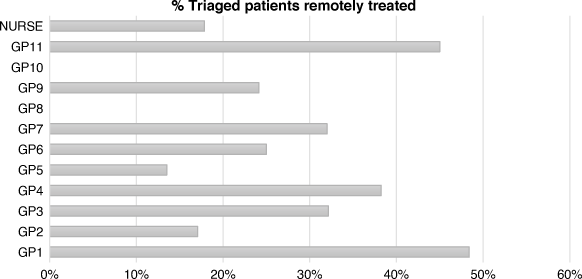
Fig. 5. Proportion triage calls by clinician (n = 455).
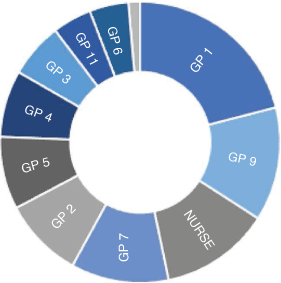
Over the 6 study weeks, 19 patients (14% of the triage-patients who were treated virtually (19/133)) were re-triaged within 7 days.
The number of patients re-triaged varied by clinician, with one GP having none of their virtually treated patients seek a follow-up triage call within 7 days.
Of the other seven GPs who virtually treated patients via telephone triage, four had one patient who was re-triaged, three had two patients re-triaged and the GP who virtually treated the most triage patients had five patients (5/45) needing to be re-triaged.
The differences in re-triage rates between clinicians were not statistically significant (P = 0.62).
Re-triage
Over the 6 study weeks there were also 34 patients who were triaged within 7 days of having been seen in-person for the same complaint.
Of these 34 patients, 11 had previously been seen in routine appointments while 23 had their care managed via telephone triage and triaged to in-person assessment.
Counting only the 23 previously triaged to in-person consultation resulted in a 7-day re-triage rate for in-person assessment of 7% (23/321).
This result showed a statistically significant reduction in re-triage rates after in-person triage compared with virtual treatment (P < 0.05, OR = 2.2, CI = 1.12–4.12). The number needed to treat (NNT) by in-person care to prevent one re-triage phone call was 13.
A review of the patients re-triaged (whether treated virtually or in-person initially) showed that younger age was a significant predictor of the likelihood of re-triage with 38% of patients re-triaged aged <5 years old.
The age distribution of re-triaged patients is shown in Fig. 6. There was no difference in re-triage rates between respiratory and non-respiratory presentations: 9% (27/300) vs 10% (16/155) respectively (P > 0.05).
… younger age was a significant predictor of the likelihood of re-triage with 38% of patients re-triaged aged <5 years old
Fig. 6. Age distribution re-triaged patients.
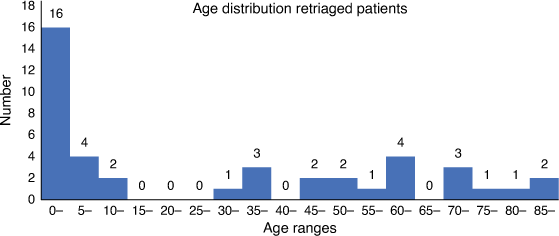
The repeat phone triages after virtual treatment that were documented in this 6-week audit (19 after phone consultations) reflect 14% of the total triage calls that were treated virtually.
When reviewed these repeat calls represented a variety of situations: ***
- Conditions not improving with conservative treatment, eg coughs not improving, conjunctivitis not settling with simple cares: 37% (7/19).
- Conditions not improving with active treatment, eg a breast abscess not settling with antibiotics, urinary tract infections not settling with antibiotics, trigeminal neuralgia not settling with nerve stabilising medications: 26% (5/19).
- Conditions that needed ongoing review of clinical status, eg ongoing diarrhoea and vomiting in infants requiring repeated hydration reassessment: 21% (4/19).
- Other situations, eg extensions to off-work certificates, back pain needing extra medication: 16% (3/19).
Finally, of re-triaged patients, 69% (29/42) were managed by a follow-up in-person review, while 31% (13/42) were treated virtually after their re-triage.
When reviewed these repeat calls represented a variety of situations: (1) Conditions not improving with conservative treatment; (2) Conditions not improving with active treatment; (3) Conditions that needed ongoing review of clinical status; (4) Other situations
Discussion
Over the past few years, New Zealand general practice has been increasingly using phone triage to manage acute health issues.
Gore Medical Centre is a general practice that has been using telephone triage to address acute health conditions for the past 2 years.
Telephone triage is also an important component of the Health Care Homes model of care which is increasingly being adopted by general practice in New Zealand.
Patient feedback locally reveals that phone triage has been well received by patients, who generally appreciate being able to seek advice or book acute appointments virtually and, in some cases, have their presenting issues dealt with directly via a triage list.
Telephone triage is a model of care provision that involves a different set of clinical skills to the usual in-person clinical care and has different limitations and challenges.
International reviews of the safety and quality of medical care provided by telephone triage have shown that patient satisfaction with this model of care provision is generally high.
These reviews have failed to show any significant differences in safety outcomes between telephone triage services and traditional methods of care.2–5 Issues around the quality of care and equity of access have been more variable.2
Studies are starting to look at the broader field of telemedicine in the context of Covid-19 pandemic. Telemedicine, whether referring to phone consultations, video consultations or other virtual modalities, offers an important way to provide safe and timely healthcare when healthcare capacity is stretched and where there are increased risks associated with in-person health-care.6,7 These studies recognise the equity issues around access that come with telemedicine.
There was a very clear association with age among patients requiring triage and re-triage, with the youngest cohort (aged ˂5 years) representing 25% of initial triage-calls and nearly 38% of patients re-triaged (16/42).
There was no clear evidence of preventable cases among patients who phoned for a repeat triage but the statistically significant difference in re-triage rates between virtual and in-person care (14% vs 7%) demonstrates that virtual treatment at Gore Medical Centre does increase the likelihood of seeking further medical input within 7 days.
This outcome affirms that in-person treatment is still the ‘gold-standard’ for healthcare while highlighting that the increased accessibility and decreased cost of telemedicine virtual care needs to be balanced against the small but significant increased likelihood of needing to seek further treatment.
A variety of factors may contribute to this increased rate of re-triage after virtual treatment as compared with in-person treatment, including the following considerations.
Telephone triage removes the ability to assess most clinical signs and is very dependent on a good history.
While the history is widely regarded as the most important part of the clinical assessment, clinical signs are also important and helpful in clarifying diagnoses.
Telephone triage reduces clinicians’ ability to read body-language and convey empathy and hope.
The healing power of clinical consultations is found in the appropriate use of medical treatments to address issues, but also in biopsychosocial and spiritual aspects where clinicians address the fears and beliefs of patients who are suffering (and of their concerned significant others).
The healing power of clinical consultations is found in the appropriate use of medical treatments to address issues, but also in biopsychosocial and spiritual aspects where clinicians address the fears and beliefs of patients who are suffering (and of their concerned significant others).
Telephone triage at Gore Medical Centre involves having a limited number of clinicians triaging each day, at specific times.
During this 6-week period only 14% of phone-calls involved a clinician calling patients who were enrolled under their own care.
It is possible that the higher rates of re-triage after virtual care were influenced by the reduced level of individual continuity in care provision.
It seems likely that triage by a clinician who knows the patient well would increase the accuracy of diagnosis and treatment as well as the confidence the patient has in that care.
It seems likely that triage by a clinician who knows the patient well would increase the accuracy of diagnosis and treatment as well as the confidence the patient has in that care.
Telephone triage at Gore Medical Centre is a service which is geared towards addressing acute health issues or acute exacerbations of existing health issues, so the sub-group of patients represented in this cohort do not represent the full spectrum of health conditions seen in New Zealand general practice and involved a time of particularly high respiratory illness.
It is not appropriate to directly extrapolate these results to telemedicine initiatives that seek to address broader aspects of primary health care. It is possible that this sub-group of patients having experienced the increased accessibility of telephone triage may also have a lower threshold to ‘check-in’ via triage and seek further medical review.
Reviewing the literature around telemedicine and telephone triage, it appears there has been limited research around the efficacy of virtual care via triage with more extensive studies around safety, subsequent Emergency Department presentation rates and utilisation rates of general practice appointments after triage.5
If 7% re-triage after in-person acute care is by definition the standard of care, then a discussion needs to be held around what rate of re-triage after virtual treatment is acceptable and appropriate.
The NNT of 13 in-person consultations required to prevent one re-triage is not an insignificant number, representing extra cost, travel and time for patients and the practice.
Reviewing the literature around telemedicine and telephone triage, it appears there has been limited research around the efficacy of virtual care via triage …
If 7% re-triage after in-person acute care is by definition the standard of care, then a discussion needs to be held around what rate of re-triage after virtual treatment is acceptable and appropriate.
Further studies in this area would be helpful to assess whether the triage results from Gore Medical Centre are reflected more widely in New Zealand General Practice.
Conclusion
This audit of telephone triage at Gore Medical Centre showed that virtual treatment via telephone triage resulted in 14% re-triage of cases over the 6-week period.
There was a statistically significant difference between virtual and in-person care in terms of the need for re-triage within 7 days with in-person treatment after triage reducing the re-triage rate to 7%.
This study did not reveal any equity issues in the provision of this service at Gore Medical Centre.
…virtual treatment via telephone triage resulted in 14% re-triage of cases over the 6-week period.
There was a statistically significant difference between virtual and in-person care in terms of the need for re-triage within 7 days with in-person treatment after triage reducing the re-triage rate to 7%.
Data availability
Data are available upon request.
Conflicts of interests
The author declares no conflicts of interest.
Declaration of funding
This research did not receive any specific funding.
Acknowledgements
The clinical staff at Gore Medical Centre who proposed this audit and assisted with feedback.
References
See original publication
Keywords: COVID-19 management, equity, general practice, telehealth, telemedicine, telephone triage, virtual care, virtual primary care, virtual treatment.
Originally published at https://www.publish.csiro.au.





